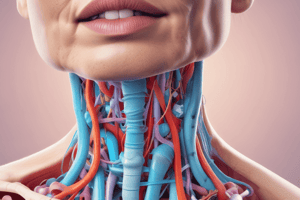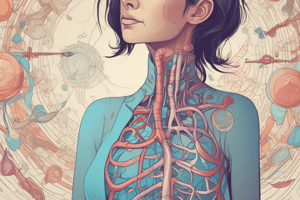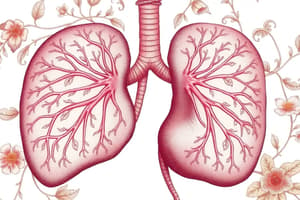Podcast
Questions and Answers
What is the recommended approach for insulin management in patients undergoing surgery?
What is the recommended approach for insulin management in patients undergoing surgery?
Continue infusions and restart subcutaneous insulin postoperatively as before surgery.
Why should Metformin be discontinued prior to surgery?
Why should Metformin be discontinued prior to surgery?
To reduce the risk of lactic acidosis.
What are the implications of using short-acting sulphonylureas on the day of surgery?
What are the implications of using short-acting sulphonylureas on the day of surgery?
Short-acting sulphonylureas should be omitted on the day of surgery.
What should be monitored if a patient's blood glucose exceeds 13 mmol/L on the day of surgery?
What should be monitored if a patient's blood glucose exceeds 13 mmol/L on the day of surgery?
List two complications associated with insulin therapy.
List two complications associated with insulin therapy.
How does insulin resistance manifest in patients?
How does insulin resistance manifest in patients?
What should be the approach to managing weight gain associated with insulin therapy?
What should be the approach to managing weight gain associated with insulin therapy?
What potential ocular complication may arise due to hyperglycemia management?
What potential ocular complication may arise due to hyperglycemia management?
What is the primary cause of hypocalcemia in hypoparathyroidism?
What is the primary cause of hypocalcemia in hypoparathyroidism?
What are some common clinical features of myxoedema in adult females?
What are some common clinical features of myxoedema in adult females?
Describe the clinical significance of Chovestek's test.
Describe the clinical significance of Chovestek's test.
What are the possible effects on ectodermal structures due to hypocalcemia?
What are the possible effects on ectodermal structures due to hypocalcemia?
What is myxoedema coma and what are its precipitating factors?
What is myxoedema coma and what are its precipitating factors?
Describe the treatment approach for myxoedema coma.
Describe the treatment approach for myxoedema coma.
How does respiratory alkalosis contribute to calcium loss?
How does respiratory alkalosis contribute to calcium loss?
What is Trousseau's sign and its relevance in hypocalcemia?
What is Trousseau's sign and its relevance in hypocalcemia?
What laboratory finding is characteristic of high TSH levels?
What laboratory finding is characteristic of high TSH levels?
Outline the main types of diabetes mellitus.
Outline the main types of diabetes mellitus.
List two reasons for diminished calcium intake leading to hypocalcemia.
List two reasons for diminished calcium intake leading to hypocalcemia.
Explain the significance of delayed ossification centers in the context of hypothyroidism.
Explain the significance of delayed ossification centers in the context of hypothyroidism.
What treatment is recommended for acute attacks of hypocalcemia?
What treatment is recommended for acute attacks of hypocalcemia?
How can malabsorption syndrome lead to hypocalcemia?
How can malabsorption syndrome lead to hypocalcemia?
What are some neuropsychiatric manifestations of myxoedema?
What are some neuropsychiatric manifestations of myxoedema?
Which dietary component conversion is affected in patients with myxoedema?
Which dietary component conversion is affected in patients with myxoedema?
What precautions should be taken when administering local anesthesia to thyrotoxic patients?
What precautions should be taken when administering local anesthesia to thyrotoxic patients?
List the investigations required to assess hormone levels in thyrotoxicosis.
List the investigations required to assess hormone levels in thyrotoxicosis.
What are some clinical manifestations of a thyroid crisis?
What are some clinical manifestations of a thyroid crisis?
What is the treatment protocol for managing a thyroid crisis?
What is the treatment protocol for managing a thyroid crisis?
Define cretinism and mention its main causes.
Define cretinism and mention its main causes.
Describe some general features of cretinism.
Describe some general features of cretinism.
What abnormal skin manifestations are typical in patients with hypothyroidism?
What abnormal skin manifestations are typical in patients with hypothyroidism?
What are the expected laboratory findings in a patient with hypothyroidism?
What are the expected laboratory findings in a patient with hypothyroidism?
What does HbA1c indicate about blood glucose levels?
What does HbA1c indicate about blood glucose levels?
Why should uncontrolled Type 1 diabetes patients be referred to a physician before dental procedures?
Why should uncontrolled Type 1 diabetes patients be referred to a physician before dental procedures?
What are the key components of preoperative management for a Type 1 diabetes patient?
What are the key components of preoperative management for a Type 1 diabetes patient?
What is the appropriate action if a diabetic patient has a blood glucose level greater than 13 mmol/L on the day of surgery?
What is the appropriate action if a diabetic patient has a blood glucose level greater than 13 mmol/L on the day of surgery?
When should intravenous (IV) dextrose infusions be started for a diabetic patient during surgery?
When should intravenous (IV) dextrose infusions be started for a diabetic patient during surgery?
What adjustments should be made to insulin dosage based on blood glucose levels during surgery?
What adjustments should be made to insulin dosage based on blood glucose levels during surgery?
List two types of oral anti-diabetic drugs mentioned in the content.
List two types of oral anti-diabetic drugs mentioned in the content.
What is the significance of monitoring blood glucose and electrolytes after surgery in a diabetic patient?
What is the significance of monitoring blood glucose and electrolytes after surgery in a diabetic patient?
Study Notes
Hypoparathyroidism Hypocalcemia (Tetany)
- Definition: Increased neuromuscular irritability due to decreased ionized calcium or magnesium
- Etiology:
- Hypocalcemia (Quantitative defect):
- Diminished Ca intake: starvation, dysphagia
- Diminished Ca absorption:
- Hypoparathyroidism: surgical removal, autoimmune destruction, goiter with diversion of blood supply from parathyroid to the enlarged thyroid gland
- Deficiency of Vit D: rickets or Osteomalacia
- Myxoedema, Panhypopitutarism, Cushing.
- Gastrectomy, atrophic gastritis, and gastric carcinoma.
- Malabsorption syndrome.
- Increased Ca loss in urine: loop diuretics
- Increased Ca precipitation in tissues: acute pancreatitis
- Alkalosis: respiratory (hysterical), metabolic (vomiting, Conn's syndrome, diuretics)
- Mg deficiency.
- Hypocalcemia (Quantitative defect):
Clinical Picture
- Latent tetany: (serum Ca 7-9 mg%)
- No spontaneous manifestations, but can be induced (provocative tests):
- Chovestek's test: Tapping of facial nerve in front of the ear causes facial muscle contraction
- Trousseau's sign: Sphygmomanometer inflation around the arm above systolic pressure for 5 minutes → carpal spasm
- Erb's sign: current < 4mA causes muscle contraction (normally at least 8 mA is needed)
- No spontaneous manifestations, but can be induced (provocative tests):
- Manifest tetany (Ca < 7 mg%):
- Muscle spasm in the form of:
- Spasm of the facial muscle
- Spasm of Jaw (trismus)
- Spasm of larynx (Laryngismus stridulous)
- Spasm of the diaphragm (hiccough)
- Spasm of the back muscles
- Carpopedal spasm, muscle twitches & convulsions
- Effect on ectodermal structures:
- Nails: Loss of luster & brittle
- Teeth: Hypoplastic, transverse furrows, and punctuate holes if the condition develops before formation of permanent teeth
- GIT: Malabsorption
- Skin: desquamation, atrophy, roughness, alopecia, and candida infection
- Hair: Premature loss of hair
- Muscle spasm in the form of:
Oral manifestations if hyperparathyroidism occurs before age 6:
- Delayed eruption of the teeth
- Wide pulp chambers
- Enamel hypoplasia
- Short roots
- Apical foramine remain open
- Multiple impacted teeth
Treatment
- In acute attacks: Ca gluconate 10 ml of 10 mg% solution SLOWLY over 10 minutes
- Treatment of the cause:
- In hypocalcemia: Oral Ca lactate 2 gm T.D.S.
Precaution should be taken with thyrotoxic patients:
- Local anesthesia should be free from adrenaline
- GA should be done by anesthetist
- Antithyroid drug induce agranulocytosis which may cause oral and oropharyngeal ulceration
- Avoid stress by prescribing tranquilizers
- Acute infection should be managed immediately
Investigations for Hormone Level:
- Total T4 & T3: increased
- Free T3 & T4: increased
- TSH: decreased
- Thyroid scan, Ultrasonography and needle aspiration biopsy
Thyroid Crisis
- Definition: Exaggerated manifestation of hyperthyroidism
- Precipitating factors: Stress, infection, surgery
Clinical picture:
- Nausea & Vomiting
- Profuse sweating
- Tremors
- Tachycardia
- Fever may reatch≥40C
- Finally, heart failure and death
How to manage thyroid crisis?
- Hydrocortisone 200 mg intravenous
- Ice pack, wet pack, fans
- Antipyretics (Acetaminophens not aspirins)
- Antithyroid drugs: Carbimazole 15-25mg/6h P.O (or via NGT if needed) after 4h give Lugol's solution 0.3ml/L/8h for 1wk to block thyroid
- B- Blockers if no contraindication
- Chloropromazine 50mg p.o/IM as a sedative
- Na+ or K+ 500 mg every 8 hrs as infusion
- Digoxin and diuretics in heart failure
Hypothyroidism
Cretinism :
- Hypothyroidism in childhood
- Causes:
- Congenital absence of thyroid gland
- Congenital enzymatic defect in synthesis of T4
- Iodine deficiency (endemic cretinism)
- Excess antithyroid drugs during pregnancy
Clinical Picture
- CNS: mental retardation, slow speaking
- General features:
- Face: puffy eye lids, depressed nose, big lips, protruded tongue, delayed dentition, Malocculsion, anterior open bite
- Hands: square-shaped, with short fingers
- Disproportionate dwarfism: height > span
- Delayed walking & waddling gait
- Hypothermia
- CVS: bradycardia
- Skin: dry, cold, scaly, with SC myxoedematous tissue deposition in hands, face & supraclavicular region
- Muscle: weakness, constipation, pot - belly abdomen
Investigations
- Low T3 T4
- TSH level: high "characteristic"
- Serum cholesterol: high
- X-ray carpal bones: delayed appearance of ossification centers & epiphyseal dysgenesis
Myxoedema:
- Hypothyroidism in adults
- Clinical Picture common in female 30-50 years
- General:
- Intolerance to cold & hypothermia
- Tiredness, weakness & weight gain
- Face
- Expressionless
- Puffy eye lids & loss of outer 1/3 of eye brows
- Malar flush
- Red glazed tongue
- May be cataract
- Skin
- Dry, cold, non sweaty, pale
- Non pitting edema: due to SC mucinous material
- Nails are thick; body hair is sparse & brittle.
- Colour: yellowish due to carotinemia (lack of conversion of carotene to Vit A in liver due to absence of T4)
- CNS:
- Slow cerebration, apathy, poor memory - Rarely myxoedema madness
- Speech: slurred speech (mucinous material in tongue) with hoarseness of voice
- Nerve deafness.
- Peripheral neuritis, carpal tunnel syndrome.
- Suspended jerks: delayed relaxation of tendon jerk
- Myxoedema coma.
- General:
Myxedema Coma
- Precipitating factor: Trauma, surgery, cold, narcotics, GA anesthesia, infections
- Hypothermia(cold) leads to muscle rigidity with both metabolic & resp.acidosis and multisystem depression (brain, heart, kidneys, liver).
- Mortality is at least 50%.
- Sedatives (diazepam), analgesic (codeine) should be avoided or the dose must be reduced
- Mortality is at least 50%.
Manifestation:
- Hypothermia
- Bradycardia
- Hypotension
- Epileptic seizures
Myxedema coma Treatment:
- Gradual rewarming
- Oxygen, ventilatory & CVS support
- Glucose IV for hypoglycemia
- Drugs:
- An intravenous loading dose of 500-800 mcg of levothyroxine is followed by a daily intravenous dose of 50-100 mcg; the daily dose is administered until the patient is able to take medication by mouth
- Hydrocortisone100mgIV/6h
- Antibiotics for infection
Diabetes Mellitus
- Definition: Metabolic disorder of carbohydrate metabolism due to relative or absolute insulin deficiency leading to hyperglycemia + glucosuria with secondary disturbance of lipid and protein metabolism
- Etiology:
- Primary (95%)
- Secondary (5%)
- Gestational DM
- Primary DM include 2 types:
- Type I DM: Juvenile-Insulin dependent DM
- Type II DM: Maturity onset-Non insulin dependent DM
- Investigation to assess treatment efficacy:
- Glycosalated hemoglobin (HbA1c):
- Hb Alc is synthesized over the life of RBCs in proportion to the degree of glycemia prevailing, and thus gives an index of the average blood glucose over the life of Hb molecule (2-3 months). Normally it is less than 6% of total Hb, and if > 12% Poor glycemic control in the past 3 months
- Glycosalated hemoglobin (HbA1c):
Management of Diabetes
- Diet Control and exercise
- Oral Anti diabetic Drugs:
- Sulfonyl Urea (Glibenclamide(Daonil))
- Gliclazide (Diamicron)
- Glimepiride(Amaryl)
- Repaglinide (Novonorm)
- Glipizide
- Biguanides: Metformine(glucophage)
- Glucosidase inhibitors:Acarbose(glucobay)
- Pioglitazone
- New Drugs: Galvus, Galvus met (Vidagliptin/Metformin)
- Insulin
- Source of insulin
- Animal origin: porcine - bovine
- Human insulin by genetic engineering (recombinant DNA technique)
- Administration
- Insulin is given SC in different places of skin
- Insulin pump
- Insulin pens
- Source of insulin
Preoperative management
Type 1 diabetes mellitus
- The uncontrolled patient should be referred to the physician before any dental procedure
- It is usually best to admit patients 2-3 days before elective surgery, particularly if outpatient adjustments are difficult
- Ensure good preoperative control usually with short-acting insulin (or a mixture of short- and intermediate-acting insulin) twice daily
- Extra short-acting insulin can be added if necessary
- Monitor blood glucose throughout the day
- On the day of surgery starve from midnight and do not give the first dose of insulin
- Operation should be as early as possible (ie put the diabetic patient first on the list)
- Check glucose and electrolytes early on the day of surgery (defer if glucose >13 mmol/L or if there is significant electrolyte disturbance)
- Start intravenous (IV) infusions of dextrose (500 ml 10% dextrose plus 10 units of soluble insulin plus 10 mol KCL at 125 mls per hour)
- Check blood glucose and electrolytes at the end of the operation or at 1- to 2-hourly intervals
- Monitor blood glucose during surgery at least every 30 minutes.Continue this as long as blood glucose is between 5-10 mmol/L.Reduce insulin to 5 units if less than 5 mmol/L and increase to 15 units if blood glucose is 10-20 mmol/L (new infusion needed of course)
- After surgery, check glucose every 2 hours and electrolytes every 6-12 hours, adjusting infusions as necessary.Continue infusions but, when eating normally, restart subcutaneous insulin (as before surgery)
- Pre and post operative antibiotic to guard against infection and slow wound healing
- Local anesthesia with low concentration of adrenaline.
Type 2 diabetes mellitus
- Preoperatively, control should be assessed
- Patients controlled by diet alone do not usually need any special measures, providing control on diet is adequate
- It is better to use short-acting drugs (for example glipizide)
- Remember that the hypoglycemic effect of sulphonylureas is enhanced by some drugs (for Example: aspirin, sulphonamides, anticoagulants)
- Metformin should be discontinued 48 hours prior to and subsequent to surgery in order to reduce the risk of lactic acidosis
- If control is inadequate, insulin may be needed
- Insulin can be required in the postoperative phase temporarily
- On the day of surgery keep 'nil by mouth' as usual and omit short-acting sulphonylurea
- Monitor blood glucose as for type 1 diabetes above. If blood glucose is >13 mmol/L, use insulin to control (small doses of soluble insulin)
- For major surgery or where there is prolonged postoperative starvation, use glucose and insulin infusions as set out above
Complications:
- Hypoglycemia & hypoglycemic coma
- Nocturnal hypoglycemia
- Blurring of vision: osmotic changes of lens
- Acute neuropathy: may occur paradoxically with controlling hyperglycemia by insulin
- Insulin edema: mild LL edema (salt & water retention)
- Weight gain
- Insulin lipodystrophy:
- Insulin lipoatrophy: Autoimmune reaction to non-human insulin
- Insulin lipohypertrophy: lipogenic effect of insulin
- Allergy: use human insulin
- Insulin resistance: defined as daily requirements > 200 IU due to:
- Obesity: commonest cause for mild resistance
- Antibodies against insulin preparations (non-human)
- Antibodies against insulin receptors
Studying That Suits You
Use AI to generate personalized quizzes and flashcards to suit your learning preferences.
Related Documents
Description
Test your knowledge on hypoparathyroidism and its effects, including the causes of hypocalcemia and associated clinical symptoms. This quiz covers definitions, etiology, and clinical presentations related to neuromuscular irritability. Prepare to enhance your understanding of this important endocrine condition.




